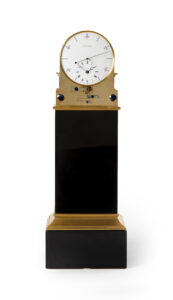TABLE REGULATOR J.S. Bourdier Hger Mechanicien à Paris Circa 1790 France
M&R27a
TABLE REGULATOR
Signed: J.S. Bourdier Hger Mechanicien à Paris
Enamel signed: Dubuisson
Circa 1790
France
Movement:
The spring-driven movement consists of going and striking trains. The going train has a pinwheel escapement and compensation pendulum with knife-edge suspension. The striking is controlled by a count wheel on the backplate and indicates the hours fully and the half hours with one stroke on a bell.
Dial:
The white enamelled circular dial has several chapter rings. The outer chapter ring consisting of red Arabic numerals (1-31) is for the date indication. The date is indicated by a straight steel hand. The next chapter ring is formed by a minute track. Blue Arabic numerals indicate every 10 minutes, a trident motif as a five-minute marker and dots for the remaining minutes. The ring with black Roman numerals is for the hour indication. There are arcs around the hour numerals, which meet at a flower. This flower serves as a half-hour marker. The time is indicated by a fine pair of fire-gilt brass hands, the hour hand being pierced in a symmetrical motif. The inner ring with strokes serves as a seconds ring. The seconds are indicated by a shorter straight counterbalanced blued-steel hand. The winding holes are at the IIII and VIII in the centre. The dial is signed by the maker in the lower part as follows: J.S. Bourdier Hger Mechanicien à Paris. The signature of the enameller Dubuisson is applied in red letters at the bottom of the dial. The dial is protected by convex glass that is set in a fire-gilt bezel embellished with pearl strings, which also serves as a door.
Case:
The mahogany-veneered case has glass panels on four sides. There is also a glazed window in a removable panel on the top. It has mouldings all around turning the case into a most elegant whole, with gilt cast brass ornaments in the top corners above the dial in the shape of leaf patterns. Below the dial is a beautifully cast gilt lambrequin. The case rests on four smooth gilt-brass block feet.
Duration 1 week.
Height 41,5 cm.
Width 22,5 cm.
Depth 17,5 cm.
Literature:
Tardy, Dictionnaire des Horlogers Français, p. 74 and 193.
The maker:
Jean-Simon Bourdier became master in 1787. He worked at the Quai de l’Horloge around 1800, and in the Rue Mazarine around 1806. He was based at Rue Saint-Sauveur from 1810 to 1820. About 1830 on the Rue Saint-Denis. He made a mantel clock with astronomical indications and time equation with a year-duration without having to be wound. He also made a clock for the king of Spain. This mantel clock had two movements and struck the hours and half hours. In the Conservatoire des Arts et Métiers in Paris is a clock with a remontoir by his hand.
The enameller:
Dubuisson was an enameller of dials and watch cases. In 1795 he was working in the Rue de la Huchette. In the Rue de la Calandre from 1812-1820. He usually signed the counter-enamel with Dubuisson.














